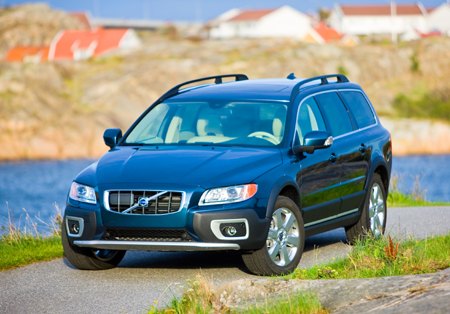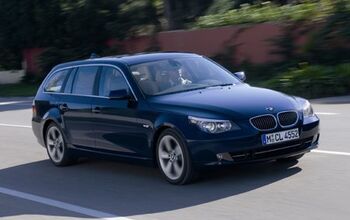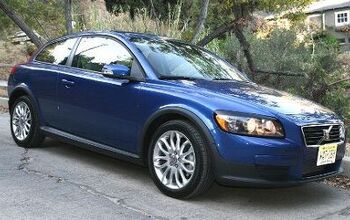Review: 2009 Volvo XC70 T6 Review
Saab’s 9-3 Turbo X SportCombi doesn’t live up to the make’s potential. So, what’s someone seeking a Swede that can haul (cargo as well as ass) to do? Well, Volvo also offers a wagon powered by a turbo six. Any enthusiast would prefer a turbocharged V70 to a turbocharged XC70, the latter essentially a V70 with high ride height, less grippy treads and SUVish exterior styling. But, thanks to lack of enthusiast love for the last R, the V70 isn’t available with a turbo in the U.S. So if you want power in a midsize Volvo wagon, it’ll have to be the XC70.
Stylistically, the 2001-2007 XC70 was a poorly proportioned patchwork, especially when light-colored paint was paired with dark fascias. On some cars, the base model has cheap-looking unpainted bumpers. In the old XC70’s case that look cost extra. The new XC70 looks much better— the SUV cues integrate with the brawnier new design. Even with light paint, the dark cladding no longer appears tacked-on. Instead, the various bits now flow cleanly from end to end. Best of all, the silly rearmost side window-shrinking inserts are gone. Aside from plus-one rims, the turbocharged T6 looks just like the regular XC70— a clue to the point of the extra horses.
The current Volvo V70/XC70 is essentially the S80 in wagon form. In a $56k flagship sedan, the mostly shared interior doesn’t impress. In a $46k wagon, it does. Materials look and feel first rate. The combination of heavily grained off-black soft leather, matte-finished dark wood and real chrome accents oozes tastefully restrained Scandinavian style. Comparisons to the Saab 9-3 also play heavily in the Volvo’s favor.
Traditionally, the primary reason people buy Volvos has been safety. The second reason: seat comfort. Or at least it ought to be. The XC70’s front seats are among autodom’s most comfortable chairs. Lateral support is also good, considering this car’s mission. The rear seat is merely adequate in terms of both room and comfort, but still considerably better than in the Saab 9-3.
In previous generations a rear-facing third row, good for occasional child use, was available. Volvo has decided that anyone who needs to carry more than five people should get the full SUV treatment offered in the XC90. So no more third row in the wagons. Thanks to an unapologetically wagonish rear roofline, the XC70’s cargo area ranks as the most voluminous among today’s shrunken population of U.S.-market wagons. The cargo area carpeting looks and feels so nice that you’ll want to put it into protective custody beneath the optional accessory load liner.
When it moved from the old S60 platform to the new S80 platform last year, the XC70 picked up a few hundred pounds of curb weight, for a total over two tons. As a result, the new 235-horsepower 3.2-liter inline six wasn’t up to the task, even when hitched to a six-speed automatic. Enter the turbo, which bumps output to 281 horsepower even with a reduction in displacement. That’s not a lot of power for a 3.0-liter turbo; this is clearly a low-pressure design optimized for driveability rather than full-throttle performance.
And so it plays out on the road. The XC70 T6 doesn’t feel quick the way the top Saab does, but it feels considerably stronger than the 3.2. With the boost, acceleration in regular driving feels appropriately effortless. A Haldex all-wheel-drive system that preloads the rears means no embarrassing tire squeal (even if you floor the throttle mid-turn) and no torque steer.
Chassis tuning is much the same. You won’t want to seek out a curvy road. But when pushed, the XC70 behaves better than a wagon-on-stilts on SUV-wannabe treads has a right to. We’re torquing limited amounts of roll and plow, very good composure and a workable amount of grip. The all-wheel-drive system lacks enthusiast-friendly tricks, but helps balance the chassis. And the extra power provided by the turbo reduces perceived bulk on the road (the base XC70 can feel ungainly). Sadly, numb steering remains embedded in Volvo’s DNA. Aside from the occasional unexpected jolt, the car rides smoothly and quietly.
By avoiding a sportwagon mission and the expectations that follow, Volvo has crafted a more satisfying wagon than Saab. Though not fun to drive, the XC70 T6 is exceedingly pleasant to drive, thanks to the butt-and-back-cosseting front seats, premium interior and smooth, quiet ride. The regular XC70 falls short on oomph even for the mainstream market; the turbo fixes this. So, if exceedingly pleasant is what you’re looking for, and the $40k+ price looks good compared to the German competition, then Volvo has a wagon for you. If, on the other hand, you’ve been waiting for a better R, you’ll be waiting for a very long time.
Michael Karesh lives in West Bloomfield, Michigan, with his wife and three children. In 2003 he received a Ph.D. from the University of Chicago. While in Chicago he worked at the National Opinion Research Center, a leader in the field of survey research. For his doctoral thesis, he spent a year-and-a-half inside an automaker studying how and how well it understood consumers when developing new products. While pursuing the degree he taught consumer behavior and product development at Oakland University. Since 1999, he has contributed auto reviews to Epinions, where he is currently one of two people in charge of the autos section. Since earning the degree he has continued to care for his children (school, gymnastics, tae-kwan-do...) and write reviews for Epinions and, more recently, The Truth About Cars while developing TrueDelta, a vehicle reliability and price comparison site.
More by Michael Karesh
Latest Car Reviews
Read moreLatest Product Reviews
Read moreRecent Comments
- SCE to AUX All that lift makes for an easy rollover of your $70k truck.
- SCE to AUX My son cross-shopped the RAV4 and Model Y, then bought the Y. To their surprise, they hated the RAV4.
- SCE to AUX I'm already driving the cheap EV (19 Ioniq EV).$30k MSRP in late 2018, $23k after subsidy at lease (no tax hassle)$549/year insurance$40 in electricity to drive 1000 miles/month66k miles, no range lossAffordable 16" tiresVirtually no maintenance expensesHyundai (for example) has dramatically cut prices on their EVs, so you can get a 361-mile Ioniq 6 in the high 30s right now.But ask me if I'd go to the Subaru brand if one was affordable, and the answer is no.
- David Murilee Martin, These Toyota Vans were absolute garbage. As the labor even basic service cost 400% as much as servicing a VW Vanagon or American minivan. A skilled Toyota tech would take about 2.5 hours just to change the air cleaner. Also they also broke often, as they overheated and warped the engine and boiled the automatic transmission...
- Marcr My wife and I mostly work from home (or use public transit), the kid is grown, and we no longer do road trips of more than 150 miles or so. Our one car mostly gets used for local errands and the occasional airport pickup. The first non-Tesla, non-Mini, non-Fiat, non-Kia/Hyundai, non-GM (I do have my biases) small fun-to-drive hatchback EV with 200+ mile range, instrument display behind the wheel where it belongs and actual knobs for oft-used functions for under $35K will get our money. What we really want is a proper 21st century equivalent of the original Honda Civic. The Volvo EX30 is close and may end up being the compromise choice.






































Comments
Join the conversation
As an Audi Allroad owner, I wish Audi would still sell the Ar instead of the stupid Q7. When compared head to head the Ar always spanked the XC70. See my blinged out AR here: http://www.mjposner.com/allroad/webshot.jpg
hello all you volvo fans and not so fans! im looking for information on a 2001 volvo xc70.